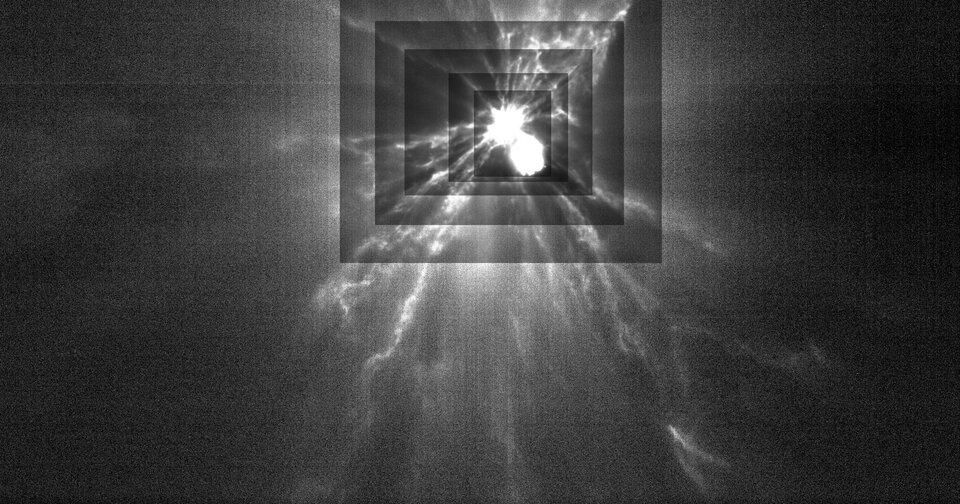What colour is an asteroid? Hyperspectral imager to find out
What colour is an asteroid? The latest instrument being prepared for ESA’s Hera mission for planetary defence will observe its target Dimorphos asteroid in a range of colours far beyond the limits of the human eye. In the process Hera’s HyperScout H hyperspectral imager will help prospect the asteroid’s mineral makeup – in the process helping to deduce how best to deflect future asteroids which might one day endanger Earth.

Around the size of a shoebox, HyperScout H is the newest design in a family of hyperspectral imagers developed for Earth observation and planetary science by cosine Remote Sensing in the Netherlands. HyperScout H has undergone a formal ‘key inspection point’ for flight aboard ESA’s Hera mission, which is due to be launched in October 2024.
A team of experts from ESA and cosine performed an inspection of the HyperScout H flight unit in cosine’s cleanroom in Sassenheim, the Netherlands.

Hannah Goldberg, ESA’s Hera system manager, explains: “The next step is environmental testing of the instrument, which takes place at ESA’s Mechanical Systems Laboratory in our nearby ESTEC technical centre. We are harnessing their wide range of testing capabilities to verify that HyperScout H can endure the conditions that Hera will experience in space.”
Hera is Europe’s contribution to an international planetary defence experiment. Following the DART mission’s impact with the Dimorphos asteroid last year – modifying its orbit and sending a plume of debris thousands of kilometres out into space – Hera will return to Dimorphos to perform a close-up survey of the crater left by DART. The mission will also measure Dimorphos’ mass and make-up, along with that of the larger Didymos asteroid that Dimorphos orbits around.

HyperScout H will contribute to that goal by gathering crucial mineralogical data to help scientists and future mission planners better understand asteroid compositions and structures.
“Having hyperspectral measurements can significantly contribute to our characterisation of asteroids,” comments Paolo Martino, ESA Hera Deputy Mission Manager. “Specific to the Hera mission, it will help us determine the composition of the asteroid.
“We are visiting an asteroid that has received an impact from NASA’s DART mission, which has generated a crater with a huge distribution of material. Having hyperspectral measurements will help us understand exactly the dynamic of the impact. This is fundamental for the modeling of the physics of the impact, and therefore to understand the technique of impacting and deflecting asteroids and how we can use it in the future in case of need.”
The technology is already proven in space: HyperScout 2 flew aboard ESA’s GomX-4B CubeSat in 2018, delivering hyperspectral 200 x 150 km views of Earth. An updated HyperScout 2 incorporating onboard AI processing and a new thermal infrared channel was launched on the FSSCAT CubeSat in 2020.

Marco Esposito, Remote Sensing Managing Director of cosine explains that while the HyperScout instrument has been employed for Earth observation, it originated in the planetary science realm: “We looked, together with ESA, at missions to Jupiter, Mercury and Venus, where hyperspectral measurements helped characterise aspects of these planets. Starting from there we developed HyperScout in collaboration with ESA’s Directorates of Technology, Engineering and Quality and Earth Observation, and we now have a good market share for this type of instruments and applications.
“HyperScout is a perfect instrument to help us with early detection and warning, enabling us to act fast and prevent major catastrophes resulting from events such as wildfires and flooding. In addition, HyperScout can help solve environmental challenges, such as climate change and the resulting adaptation of plants.

“We are really honored to become an integral part of ESA’s Hera mission and expect more planetary science missions in the future, since many private parties are looking into such missions, for example for asteroid mining.”
Pierluigi Foglia Manzillo, cosine's project manager for HyperScout H, adds: “The test readiness of the HyperScout H flight model comes after multiple years of cosine activity in the context of the Hera mission. We designed and developed a hyperspectral payload which fully exploits its flight heritage in the context of Earth observation and has been adapted to the environmental and performance requirements of an interplanetary mission. The outcome is a compact and high-performance instrument that will greatly contribute to reaching the Hera science goals.
“I am proud of leading a large team of talented professionals who made this success happen and I would like to express my gratitude for their hard work and dedication. We now confidently look forward to the instrument test phase and to its integration in the Hera spacecraft."


Access the video














 Germany
Germany
 Austria
Austria
 Belgium
Belgium
 Denmark
Denmark
 Spain
Spain
 Estonia
Estonia
 Finland
Finland
 France
France
 Greece
Greece
 Hungary
Hungary
 Ireland
Ireland
 Italy
Italy
 Luxembourg
Luxembourg
 Norway
Norway
 The Netherlands
The Netherlands
 Poland
Poland
 Portugal
Portugal
 Czechia
Czechia
 Romania
Romania
 United Kingdom
United Kingdom
 Slovenia
Slovenia
 Sweden
Sweden
 Switzerland
Switzerland



























